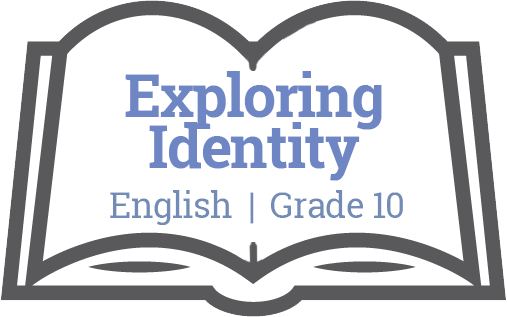
Unit Plan: Exploring Identity
English Language Arts / Grade 10

Big Ideas
The exploration of text and story deepens understanding of one’s identity, others, and the world.
Concepts:
- Identity
- Nature vs. Nurture
- Perspective/Voice in texts
Essential Questions
Students will keep considering…
- Who am I? How do I define myself ? How does my identity change and evolve?
- How does making connections between text and self deepen my understanding of my own identity?
- How does understanding my own identity help me to connect and empathize with others?
Evaluative Criteria
TEACHER EVALUATIVE CRITERIA
Criteria
Formative assessment:
Observation in class, participation in activities for each short story, completion of skill/knowledge components
Formative tasks:
- Box of Self
- Elements of Short Stories: completion of charts for all stories
- Reflective writing tasks based on three of the short stories
- Character monologue
- Self, peer and teacher feedback and reflection—ongoing throughout the unit
- Checkpoint quizzes
Summative assessment:
Personal Profile Performance Task
Rubric:
See attached Personal Profile rubric (DOWNLOAD)
Adaptations:
- Read aloud of all short stories: focus on the understanding of identity, not individual reading and decoding skills.
- Refer to NVSD Adaptations Checklist for further support
- Work with Learning Services staff to support with adaptations for students with IEPs
Differentiation:
- Requirements of the performance task product can be differentiated based on learning styles and needs
- Student choice in texts/sources: poetry, short stories, novels, web articles, non-fiction, movies, songs, documentaries, TV shows etc.
- Student choice in the presentation of the Personal Profile: blog, website, Prezi, PowerPoint, Show Me, Vlog etc.
Extension:
Students can add other components to the personal profile that include connection to the similar Big Ideas in other curricular areas
Monitoring Progress
Teacher will monitor progress:
Criteria:
Use techniques to check for understanding: exit tickets, quizzes, student interviews, observation, mini group presentations etc.
Differentiation:
- Allow students to select their own short stories for discussion, use videos or Totals around the identity theme, read aloud of text, partner activities as needed, use LAC teacher to support differentiation
- Lesson activities can be differentiated based on learning styles and student needs
Resources
Suggested Short Stories
Wild Horses by Brian Fawcett, The Persian Carpet by Hanan Shaykh, Legend of the Sugar Girl by Joseph Boyden, On the Sidewalk, Bleeding by Evan Hunter, Just Lather, That’s All by Hernando Telles
See also:
Reflection
How will teachers and their students reflect on and evaluate the completed project?
Constant feedback from students and dialogue after each activity outlined in the Learning Events will help to direct and adapt what is explored in the next activity. Self, peer and teacher evaluation of the Performance Task and its alignment with the essential questions.
Teacher:
Next time I teach this unit I would…
Allow students to select the short stories that link to Identity.
Student:
My students needed:
Process:
Product:
Content:
Potential Student Misunderstanding:
Unit Overview
Subject
English Language Arts
Topic
Exploring Identity
Unit Overview
This unit will use the Short Story genre to explore essential questions around identity and deepen student understanding of themselves and their connection to literature. The unit could also be used with poetry, a class novel study, or literature circles. Identity could also be the overarching, theme/big idea for the entire year of study in English 10. The interdisciplinary links between Art and Socials could be explored and used to enrich the learning events and support the transfer goals.
Grade
10
Unit Duration
4 – 6 weeks
Related Big Ideas
Arts: 10-12
Dance, Drama, Music and Visual Art offer unique and dynamic ways of expressing and exploring one’s identity and sense of belonging.
Social Studies: 10-12
Our changing world presents challenges for First Peoples in maintaining their identities and worldviews.

The following resources are made available through the British Columbia Ministry of Education. For more information, please visit BC’s New Curriculum.
Big Ideas
The Big Ideas consist of generalizations and principles and the key concepts important in an area of learning. The Big Ideas represent what students will understand at the completion of the curriculum for their grade. They are intended to endure beyond a single grade and contribute to future understanding.
Core Competencies
 Communications Competency
Communications Competency
The set of abilities that students use to impart and exchange information, experiences and ideas, to explore the world around them, and to understand and effectively engage in the use of digital media
 Thinking Competency
Thinking Competency
The knowledge, skills and processes we associate with intellectual development
 Social Competency
Social Competency
The set of abilities that relate to students’ identity in the world, both as individuals and as members of their community and society
Curricular Competencies & Content
Curricular Competencies are the skills, strategies, and processes that students develop over time. They reflect the “Do” in the Know-Do-Understand model of curriculum. The Curricular Competencies are built on the thinking, communicating, and personal and social competencies relevant to disciplines that make up an area of learning.
Additional Resources
First People's Principles of Learning
To read more about First People’s Principles of Learning, please click here.
For classroom resources, please visit the First Nations Education Steering Committee.
